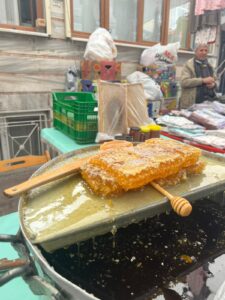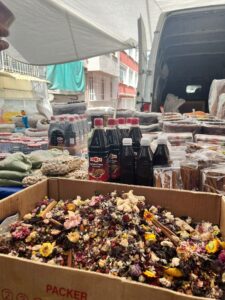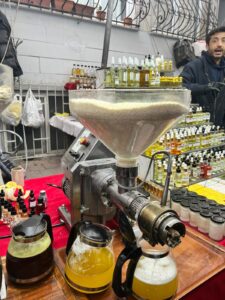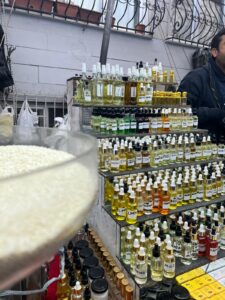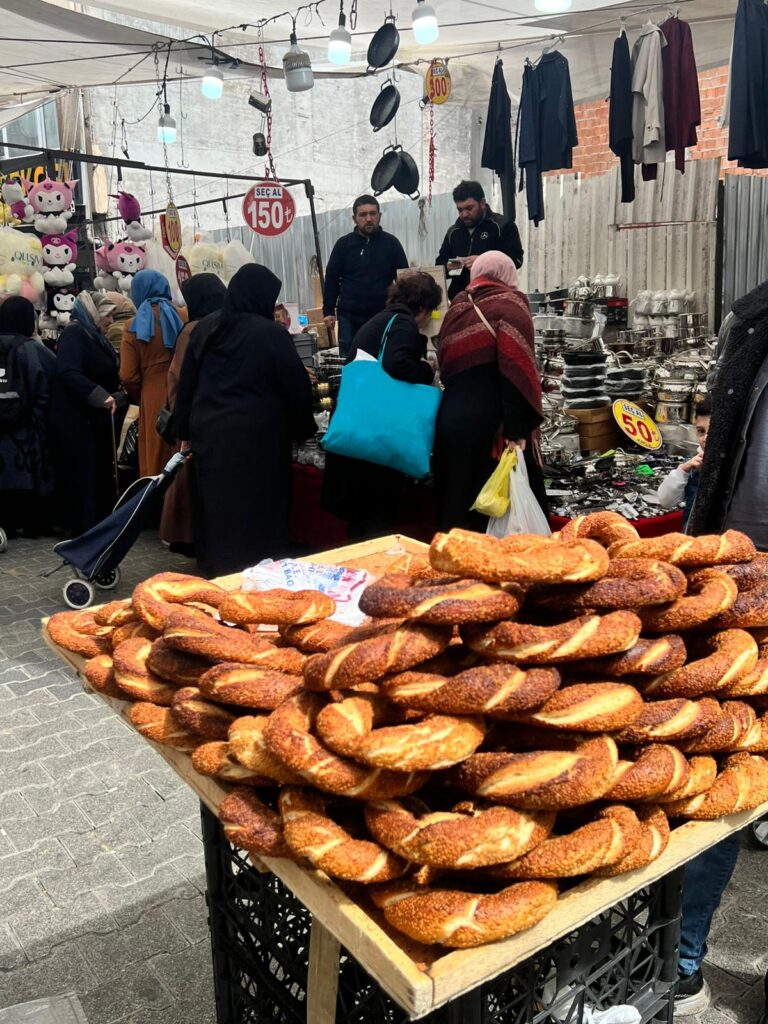
Intro: The Market as a Mirror of the Soul
“A pazar is not chaos, it is choreography.”
in the heart of Istanbul’s historic Fatih district, beneath the grand Fatih Mosque—built in 1463 by Sultan Mehmet the Conqueror—Istanbul’s oldest surviving weekly market, Fatih Çarşamba Pazarı, has unfolded every Wednesday for over five centuries. Born as a humble gathering for pilgrims and scholars visiting the mosque’s hospital (darüşşifa) and theological schools, this pazar grew into a beating heart of Ottoman daily life. Today, it remains a living archive of Istanbul’s soul, where the scent of ıhlamur (linden blossom) mingles with the murmur of prayers, and every stall holds a story waiting to be unraveled.
For healing travelers, this is not a market to see—it’s a ritual to live. Divided into eight vibrant sections—from herbal apothecaries to fabric weavers, copper forgers to olive vendors—the pazar invites you to wander its labyrinth with intention. Here, the act of buying sage becomes a conversation with history, and a hand-stitched textile transforms into a map of forgotten emotions.
A Living Ritual, Born in 1463
When Sultan Mehmet II commissioned the Fatih Mosque complex, he envisioned more than a place of worship. It was a self-sustaining ecosystem: a hospital for healing, a library for knowledge, and a çarşamba pazarı (Wednesday market) to nourish both body and community. Over 550 years later, the market still thrives as a testament to Ottoman ingenuity.
Sections to Explore:
Şifalı Bitkiler (Healing Herbs): Stalls piled with thyme for courage, linden flowers for calm, and black seed oil for purification.
Kumaşçılar (Textile Weavers): Hand-dyed silks and linens embroidered with Ottoman motifs—tulips for divine love, pomegranates for abundance.
Bakırcılar (Coppersmiths): Artisans hammering pots believed to enhance food’s vitality, just as they did in the mosque’s 15th-century soup kitchen.
Zeytin & Peynir (Olives & Cheese): Tables overflowing with brined treasures, a legacy of Anatolia’s ancient trade routes.
Seekers, Not Just Tourists: What This Guide Reveals
This isn’t a typical market guide. For the healing traveler, we’ve woven together:
History: How the pazar’s layout mirrors the Ottoman “külliye” concept—a holistic space blending faith, health, and community.
Symbolism: Decoding the hidden meanings in herbal remedies (e.g., sage for cleansing negative energy) and textile patterns (carnations for courage).
Practical Magic: Where to find the best çörek otu (black seed oil) or a prayer rug .
Rituals to Try: How to haggle like a local (hint: smile and ask, “Bu son fiyat mı?” – Is this the final price?), or share tea with a vendor whose family has sold spices here since the 1800s.
Why Healing Travelers Return Here
Timeless Continuity: The same cobblestones that once supported Ottoman hospital patients now guide modern seekers to herbalists prescribing ancestral remedies.
Sacred Geometry: The market’s circular layout—radiating from the mosque—mirrors the Sufi concept of the soul’s journey: outward exploration, inward reflection.
Your Invitation: To touch fabrics dyed with pomegranate rind, taste olives cured with thyme from the Aegean, and feel the weight of a copper cup that’s held generations of çay.
“In Fatih Çarşamba Pazarı, time is not linear—it’s a spice rack, and every jar holds a different century.”
Whether you’re looking for the best bazaars in Istanbul for traditional Turkish goods, or a quiet space to reconnect with yourself, Fatih Çarşamba Pazarı offers both.
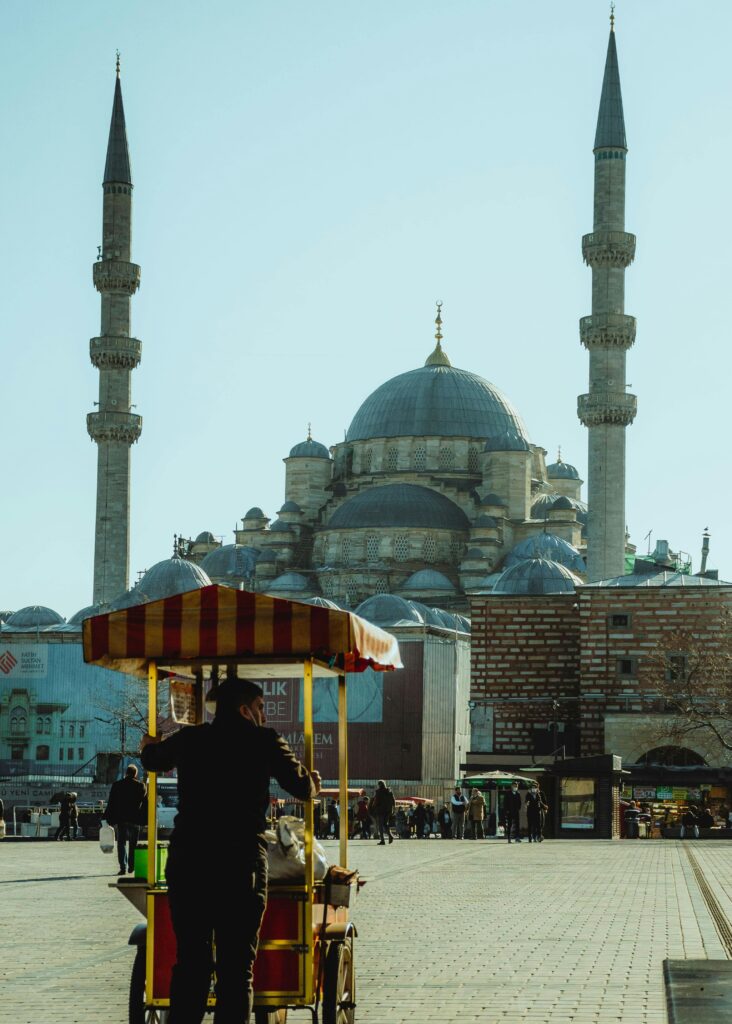
Practical Essentials: Navigating Fatih Çarşamba Pazarı Like a Local
Your blueprint for a seamless, soulful market experience
Location & Timing
📍 Where: Woven into the streets surrounding Fatih Mosque (Fatih Camii), Istanbul’s historic peninsula.
🗓️ When: Every Wednesday, 7:00 AM – 7:00 PM (peak crowds 10:00 AM – 3:00 PM).
🕋 Sacred Timing: For quieter exploration, arrive early morning (7:00–9:00 AM) or after Dhuhr (noon prayer)—around 1:00 PM—when locals pause to pray, softening the market’s tempo.
🚌 How to Reach:
Tram: T1 Line to Aksaray or Emniyet-Fatih, followed by a 10-minute walk through Ottoman-era streets.
Metrobus: Exit at Topkapı and take bus 87 or 36V to Fatih.
Bus: Lines 31E, 32, 36KE, or 87 stop near the mosque.
Market Layout: A Labyrinth of Stories
🗺️ Structure: The pazar spills across narrow cobblestone streets and tucked-away lanes, merging seamlessly with local life. Think of it as an open-air museum with eight key sections:
Textiles & Clothing: Bolts of kutnu silk and hand-embroidered scarves near the mosque’s western gate.
Household Goods: Copperware, ceramics, and woven baskets along Çarşamba Pazarı Caddesi.
Healing Herbs & Spices: Look for clustered aktar (herbalist) stalls with sacks of ıhlamur (linden) and çörek otu (black seed).
Street Food: Simit carts, gözleme griddles, and olive vendors near the mosque’s courtyard.
Accessories: Prayer beads (tespih), silver jewelry, and leather goods in the eastern lanes.
🧭 Pro Tip: Let the minaret of Fatih Mosque guide you—it’s your North Star if you get lost.
Tips for Visitors in Fatih Pazar in Istanbul: Wisdom from the Cobblestones
Dress the Part:
Modest Attire: Cover shoulders and knees out of respect (scarves sold at the market make perfect impromptu cover-ups).
Comfort First: Wear sturdy shoes—the cobblestones are charming but uneven.
Cash is King:
Most vendors only accept Turkish Lira. ATMs are sparse—bring small bills (20–100₺) for easier haggling.
Haggle with Heart:
A smile and polite “Biraz indirim yapabilir misiniz?” (Can you lower the price?) work wonders. Avoid aggressive bargaining—this is a social ritual, not a battle.
Eat Like a Local:
Grab a simit (sesame bread) and çay (tea) from a street cart for breakfast.
Try tahinli pide (sesame pastry) from bakeries near the mosque—a Ottoman-era energy boost.
Respect the Rhythm:
Pause during the ezan (call to prayer)—vendors often stop to pray, offering a moment to reflect.
Why This Matters for Healing Travelers
Fatih Çarşamba Pazarı in Istanbul isn’t just a market—it’s a lesson in mindfulness. Navigating its chaos teaches patience; haggling for herbs becomes a meditation; sharing çay with a vendor bridges cultures. Here, every step is a chance to connect—with history, with strangers, and with yourself.
“In these streets, the past isn’t preserved behind glass—it’s folded into the creases of a linen scarf, steeped in a cup of sage tea.”

Historical Significance: Where Stones Whisper Stories of Healing & Community
Unraveling the Ottoman Soul of Fatih Çarşamba Pazarı
Fatih Mosque & Its Legacy: The Conqueror’s Vision of Holistic Care
In 1463, just a decade after conquering Constantinople, Sultan Mehmet the Conqueror (Fatih Sultan Mehmet) commissioned a monument to his empire’s soul: the Fatih Mosque Complex. More than a place of worship, it was a revolutionary blueprint for Ottoman society—a “külliye” designed to nourish mind, body, and spirit.
Healing at the Darüşşifa: Within its walls, the empire’s first hospital (darüşşifa) treated patients with herbs like kekik (thyme) and ıhlamur (linden), remedies still sold in today’s pazar. Scholars, mystics, and physicians debated here, blending Islamic medicine with Greek wisdom.
Feeding the Soul & Body: The complex’s soup kitchen (imaret) fed thousands daily, while its theological schools (medrese) trained future leaders. This ethos—care as worship—still pulses through the market’s lanes.
The Market’s Origins: A 550-Year-Old Dance of Commerce & Compassion
The Fatih Çarşamba Pazarı began as a humble gathering of traders serving pilgrims, students, and patients from the mosque complex. Over centuries, it grew into Istanbul’s beating heart of social cohesion—a place where silk merchants, spice sellers, and copper smiths sustained a community bound by faith and mutual care.
15th-Century Time Capsule: Imagine Ottoman women bartering for linen to sew çeyiz (dowry) textiles, or scholars buying parchment and ink from stalls that once stood where today’s herbalists brew sage tea.
A Living Anchor: While empires rose and fell, the pazar endured—through plagues, wars, and modernization—retaining its role as a Wednesday ritual. As a local vendor once told me, “This market isn’t ours; we borrow it from our ancestors.”
Architectural Insights: Ottoman Urban Planning as Sacred Geometry
The Ottomans didn’t just build mosques and markets—they wove them into a sacred tapestry of daily life.
Mosque-Market Symbiosis: The pazar’s labyrinth of lanes radiates from the Fatih Mosque, mirroring the Ottoman belief that spiritual and earthly needs are intertwined. Covered arcades (bedesten) sheltered traders, while nearby caravansaries hosted Silk Road merchants, creating a microcosm of the empire’s reach.
Caravansaries & Covered Bazaars: These weren’t mere buildings but sanctuaries of exchange. Travelers rested in courtyards scented with rosewater, their goods—Persian saffron, Egyptian cotton—testaments to a connected world.
Why Healing Travelers Feel This Legacy
Holistic Design: Just as the mosque complex blended hospital, school, and kitchen, today’s pazar merges herbs for healing, textiles for tradition, and food for connection.
Timeless Blueprint: The market’s layout—a web of narrow streets echoing Ottoman çarşı (bazaar) design—still guides seekers to hidden gems: a 17th-century herbalist’s shop, a fifth-generation copper smith.
“To walk Fatih Çarşamba Pazarı is to tread the same stones as Ottoman healers, Sufi poets, and widows stitching hope into scarves. Here, history isn’t studied—it’s lived.”
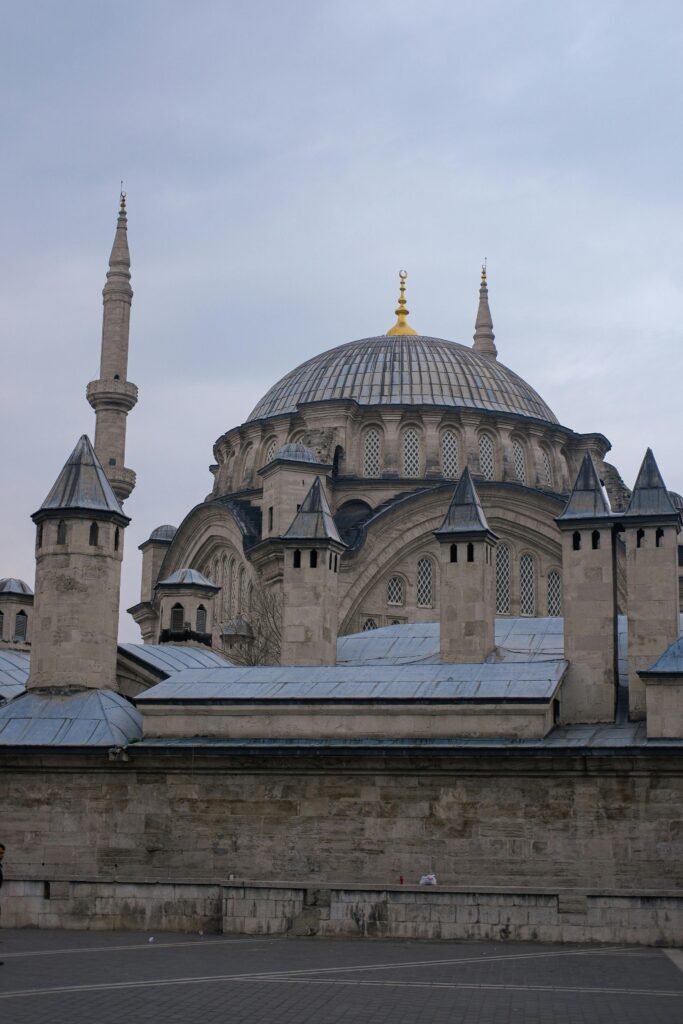
Islamic & Spiritual Heritage: The Sacred Pulse of Fatih Çarşamba Pazarı
Where Faith, Commerce, and Community Converge
Fatih Mosque: A Pilgrimage of the Heart
🕌 Tomb of a Conqueror, Sanctuary for Seekers
At the core of the market’s spiritual energy lies the Fatih Mosque, home to the tomb of Sultan Mehmet II—the visionary leader who transformed Constantinople into Istanbul. For 550 years, pilgrims have whispered prayers here, seeking wisdom from the man who bridged empires. Just steps away, the Sahaba Tombs honor companions of the Prophet Muhammad, making this site a magnet for Muslims worldwide.
Traveler’s Tip: Pause at Mehmet II’s tomb. Feel the weight of history—and the quiet power of a simple du’a (supplication).
In Islam, a tomb is meant to be a simple reminder that our journey begins from dust and ends in dust. It is not a place to seek blessings from the deceased, because they have returned to Allah and cannot help themselves, let alone others. While some people may ask the dead for help or blessings, this is not part of Islamic belief—it often comes from cultural habits or grief, not religious guidance. Instead, Islam teaches us to pray for the deceased, asking Allah to have mercy on them. Du’a flows from the living to the dead, not the other way around.
Market Rituals: Where Trade Meets Faith
🌿 Prayer Before Profit
As dawn breaks each Wednesday, vendors roll out their wares not with shouts, but with silent prayers. Many begin their day with Fajr (morning prayer) at the mosque, infusing the market with a sacred rhythm. Watch for the elderly spice seller who kisses his herbs before arranging them—a ritual passed down through generations.
🤲 Charity (Zekat) in Action
The Ottoman ethos of zekat (obligatory almsgiving) lives on here. Farmers leave crates of unsold figs for the needy, textile traders gift scarves to struggling students, and bread vendors quietly feed those who linger hungry. As one butcher told me, “God sees the hands that give, not the coins they hold.”
The Paradox of Giving in Scarcity:
“The example of those who spend their wealth in the way of Allah is like a seed [of grain] that sprouts seven ears; in every ear is a hundred grains. And Allah multiplies [His reward] for whom He wills. And Allah is all-Encompassing and Knowing.” Surah Al-Baqarah (2:261)
When funds are tight, the Shaytan whispers, “Hold onto what you have!” But Allah commands the opposite: give to unlock His mercy. A struggling mother in Fatih Pazarı once donated her last ₺10 to a refugee—and the next day, a customer overpaid her for herbs, saying, “Allah told me to give this to you.”
How to Activate This Promise:
Start Tiny, Start Now: A smile, a shared meal, or ₺5 to a street vendor counts.
Pray as You Give: Whisper, “Ya Razzaq, increase me because I obeyed You.”
Trust the Unseen: Blessings may return as health, opportunities, or inner peace—not just cash.
Fatih Pazarı’s Living Witnesses
The Bread Seller’s Miracle: A vendor who donated unsold simit to the mosque’s kitchen saw his sales triple the next week.
The Herbalist’s Secret: After giving free ıhlamur (linden tea) to sick neighbors, her shop became a pilgrimage site for healing seekers.
- The Olive Farmer’s Miracle: After gifting olives to the mosque’s kitchen, his grove survived a drought that ruined his neighbors’.
“Allah’s math is simple: You give one, He gives seven hundred. But His mercy? That’s infinite.”
Ready to test His promise? Drop coins into a donation box, buy a scarf for a widow in the market, or share this verse as sadaqah jariyah. Watch the seeds grow. 🌱
🛍️ What to Find in Fatih Pazar: Healing Traditions of Turkey Through Copper, Fabric, and Herbs
When travelers imagine a market, they expect noise, color, and perhaps a bargain. But at Fatih Çarşamba Pazarı, what you find is far deeper — a marketplace that speaks to memory, identity, and restoration. Each object here carries a story, a scent, a sound that stirs something ancient inside.
You may come looking for gifts or curiosities, but you leave with more: a sense of grounding, a moment of pause, or a symbol that mirrors something in your own journey.
The copperware, still hand-hammered by artisans, feels warm in the hand and alive with tradition — echoing a time when food was medicine, and every pot was a prayer.
The fabrics, dyed in tulip reds and dervish greens, are woven with meaning — from Ottoman gardens to wedding chests, they carry emotions stitched into every thread.
And the herbs, bundled in fragrant piles of linden, sage, thyme, and rose, are not just for cooking or tea. They were — and still are — part of spiritual healing, social rituals, and ancestral medicine.
Together, they form a sacred trio — metal, cloth, and plant — offered not as merchandise, but as portals. To history. To healing. And to the parts of ourselves we often forget in the rush of modern life.
The Copper Connection: Metalwork as Memory and Medicine
Where Metal Meets the Mystical
Copperware: The Ottoman Art of Healing & Heritage
🪔 Traditional Uses:
Copper wasn’t just a metal in Ottoman life—it was a living ritual. Hammams used copper bowls (tas) to pour water over bathers, believed to purify both body and soul. Kitchens stored honey and olive oil in copper pots to preserve their vitality, while dervishes drank from copper cups during Sufi ceremonies to symbolize humility.
⚗️ Healing Properties:
Science now confirms what Ottomans knew: copper has natural antimicrobial properties. Water stored in copper jugs (ibrik) reduces bacteria, aiding digestion and immunity. Modern studies show copper surfaces kill 99.9% of germs within hours—a fact woven into Turkish grandmothers’ insistence on using copper for ayran (yogurt drink).
🌀 Artisanal Symbolism:
Circular patterns on Ottoman trays (sini) aren’t mere decoration—they mirror Sufi cosmology, representing the infinite unity of Allah. For healing travelers, polishing a copper heirloom becomes a meditation on eternity.
note: Sufi-inspired ideas of divine unity and the soul’s journey toward Allah. While not rooted in core Islamic doctrine, these interpretations have historically offered a way for artisans and seekers to connect with the spiritual through everyday objects. For some travelers, polishing an old copper tray becomes less about ritual and more about reflection—a moment to center the self, even as traditional scholars might remind us to stay grounded in authentic teachings.
🏺 Anecdote: The Heirloom Ibrik:
In Fatih Pazarı, a vendor once showed me a 200-year-old copper ibrik passed down through her family. “Every scratch is a prayer my ancestors whispered,” she said. “Drink from this, and you drink their barakah.”
Fabrics and Threads: Weaving Identity and Prayer
Where Cloth Becomes a Conversation
Textiles: Sacred Armor & Silent Speech
🧣 Handwoven Cloth:
Ottoman women spun linen and silk into prayer shawls (namazlık), believing the act of weaving infused the fabric with du’a (supplication). Scarves dyed with pomegranate rind symbolized protection from the evil eye.
🌸 Oya: The Secret Language of Lace:
In Ottoman Anatolia, women stitched emotions into lace edges (oya) on headscarves—a silent code for suitors and in-laws:
Yellow Flowers: Jealousy (“Beware of rivals”).
Red Carnations: Passion (“My heart burns for you”).
Basil Leaves: Acceptance (“You have my family’s blessing”).
🧵 Healing Through Handiwork:
Weaving was therapy. Widows grieving sons lost in war stitched cypress motifs (symbols of mourning) into tablecloths, transforming sorrow into art. Today, Fatih’s lace-makers still murmur prayers as their needles dance.
A Traveler’s Ritual: Buy an oya scarf from Aunt Emine’s stall. Notice the purple violets—they mean “You occupy my thoughts.” Who will you silently send it to?
The Herb Stalls: Earth’s Pharmacy and Ottoman Emotional Language
Where Plants Whisper & Heal
Herbs: Nature’s Apothecary & Love Letters
🌿 Healing Staples:
Sage (Adaçayı): Clarity. Burned to cleanse homes of negativity.
Lavender (Lavanta): Peace. Placed under pillows to ward off nightmares.
Black Seed (Çörek Otu): From the Hadith: “Healing for every disease but death.” Mixed with honey for immunity.
💌 Ottoman Emotional Language (Lisan-i Nebat):
Herbs weren’t just remedies—they were emotional alphabets. To refuse a marriage proposal, a woman sent rue (sedef otu), meaning “Your envy poisons me.” To accept, she gifted basil (reyhan), signaling “You sweeten my life.”
👵 Sellers as Storytellers:
At Fatih’s herb stalls, elderly aktar (herbalists) prescribe remedies like therapists. Aunt Fatma, whose family has sold herbs here since 1890, shares: “Brides once carried thyme (kekik) in their veils for courage. Now career girls buy it before job interviews.”
A Legend: It’s said a heartbroken girl planted linden flowers (ıhlamur) at her lover’s grave. They grew into a tree whose tea now heals thousands of broken hearts in Fatih.
Why This Matters for Healing Travelers
In Fatih Çarşamba Pazarı, every copper cup, lace thread, and sage bundle is a mirror of your own journey. Here, you don’t just buy objects—you reclaim fragments of your identity:
Copper teaches release (it only shines when polished).
Oya whispers that silence can speak louder than words.
Herbs remind you that growth often begins in broken soil.
“In this market, you aren’t finding yourself—you’re remembering who you’ve always been.”

Sacred Steps: Finding Spirituality and History in Fatih’s Shadow
Explore Fatih Çarşamba Pazarı’s spiritual rhythm and nearby Ottoman-Byzantine gems. Discover how Istanbul’s soul intertwines prayer, trade, and timeless healing.
Spiritual Anchors in the Pazar: Where Commerce Meets the Cosmic
As you weave through the kaleidoscope of Fatih Çarşamba Pazarı, look up: the domes of ancient mosques hover above the stalls like celestial guardians. This is no accident—Ottoman planners designed markets to orbit around mosques, ensuring the rhythm of dunya (worldly life) and deen (faith) remained entwined.
The Dance of Devotion & Daily Life
Prayer Over Profit: At the call of ezan, vendors pause mid-haggle, spreading prayer mats between crates of figs and copper pots. A tea seller once told me, “Our shops can wait; our souls can’t.”
Divine Provision: Locals believe rizk (sustenance) flows from Allah, not effort alone. Notice how vendors toss coins into charity boxes before opening their stalls—trusting that generosity multiplies blessings.
A Moment to Steal: Join the post-Dhuhr (noon prayer) lull. Sit on the mosque steps, sip çay, and watch the market reawaken—a living metaphor for resurrection.
Nearby Healing & Historical Sites: Where Stones Speak
Just steps from the pazar’s chaos lie sanctuaries where Istanbul’s layered soul unfolds.
1. Fatih Mosque Complex: The Conqueror’s Sanctuary
Tombs & Whispers: The tomb of Sultan Mehmet II draws pilgrims seeking wisdom from the man who reshaped continents. Touch the cool marble and murmur a du’a—many swear they feel a barakah (blessing) here.
The Forgotten Library: Hidden in the complex’s courtyard, the 15th-century library holds Qur’ans inked with gold. Breathe in the scent of aged paper—a balm for modern burnout.
2. Yavuz Sultan Selim Mosque: Skyline & Spirit
A 10-minute walk uphill rewards you with panoramic views of the Golden Horn from this 16th-century mosque. Its minimalist design—a contrast to Fatih’s grandeur—reflects Sultan Selim’s austere mysticism. Local lore claims the mosque’s cats (fed by imams) carry the souls of departed Sufis.
3. Kariye Mosque (Chora Church): A Mosaic of Faiths
Once a Byzantine church, later a mosque, now a museum—Kariye is Istanbul’s spiritual palimpsest. Gaze at its golden mosaics of Christ Pantocrator, then spot the subtle mihrab (prayer niche) added by Ottomans. It’s a silent lesson in coexistence.
Why Healing Travelers Need Both
Fatih’s Lesson: The market teaches that spirituality isn’t separate from “real life”—it’s the thread weaving through it.
Kariye’s Whisper: History isn’t a monologue. Here, Christian saints and Quranic calligraphy share walls, proving beauty transcends dogma.
“In Fatih, even the apricots have stories. Every cobblestone is a crossroads of empires, every herb stall a pharmacy of memory.”
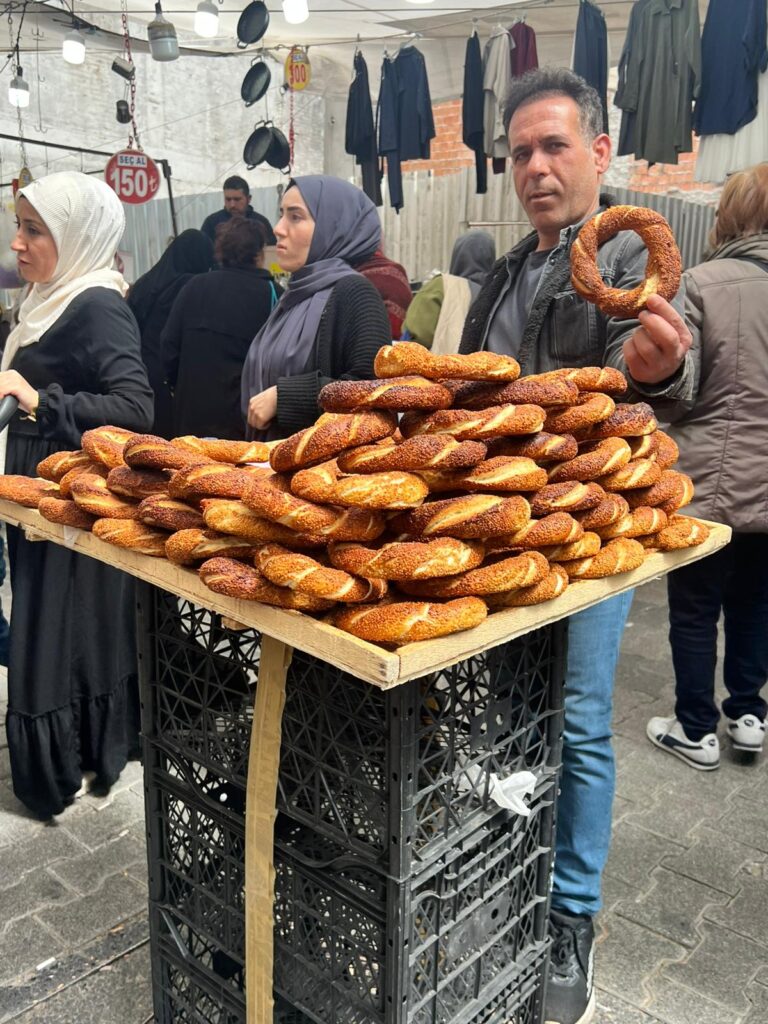
Safety & Mindful Travel: Navigating Fatih Çarşamba Pazarı with Grace
Protect your peace, honor tradition, and tread lightly in Istanbul’s soulful bazaar.
1- Crowds: Navigate the Chaos Like a Pro
Fatih’s Wednesday market thrums with energy, but its narrow lanes and lively crowds demand savvy awareness.
Pickpocket Precautions: Keep wallets/phones in zipped inner pockets or crossbody bags worn in front. Avoid flashing cash.
Peak Times: Arrive early (7–9 AM) or post-noon prayer (1–3 PM) for lighter crowds.
Local Hack: If overwhelmed, follow the flow toward the mosque courtyard—a natural “reset” point.
📿 Muslims Wisdom: “Trust in Allah, but tie your camel.” Stay vigilant, but don’t let fear overshadow joy.
2. Respectful Dress: Honor the Sacred
The Fatih Mosque isn’t just a backdrop—it’s the market’s spiritual anchor. Dress codes here blend faith and tradition:
Shoulders & Knees Covered: Lightweight scarves or loose pants work (vendors sell affordable cotton wraps).
Headscarves Optional: Non-Muslim women aren’t required to cover hair, but a scarf adds cultural respect.
👗 Pro Tip: Grab a flowy şalvar (Turkish pants) from the textile stalls—they’re modest, breathable, and double as a souvenir.
3. Sustainability: Shop Like a Steward of the Earth
Ottoman markets thrived on zero-waste principles. Channel their ethos:
Reusable Bags: Bring a tote for spices, herbs, or textiles. Many vendors still wrap goods in recycled paper.
Eco-Friendly Finds: Support artisans selling:
Beeswax wraps (replace plastic).
Copper water bottles (self-cleaning & plastic-free).
Handmade soaps wrapped in leaves.
Avoid Plastic Trinkets: Opt for heirloom-quality goods like Şile cloth towels or olive wood spoons.
🌍 Local Insight: The herbalist Aunt Emine refills spice jars for free—bring your container!
4. Mindful Engagement: Connect, Don’t Consume
Ask Before Photos: A smile and “Fotoğraf çekebilir miyim?” (May I take a photo?) build trust.
Haggle with Heart: Bargaining is expected, but keep it playful. A joke about the weather beats aggressive haggling.
Support Small Vendors: Buy a ₺10 bunch of thyme from a grandma’s stall over a corporate shop.
“In Fatih, every mindful choice—a reusable bag, a covered shoulder—becomes a bridge between traveler and tradition.”
Your Turn: What’s your go-to mindful travel hack? Share below—we’ll feature the best in our next guide! 🌿🛍️
Ready to explore responsibly? Pair this guide with our “Hidden Gems of Fatih” itinerary for a journey that honors both history and humanity.
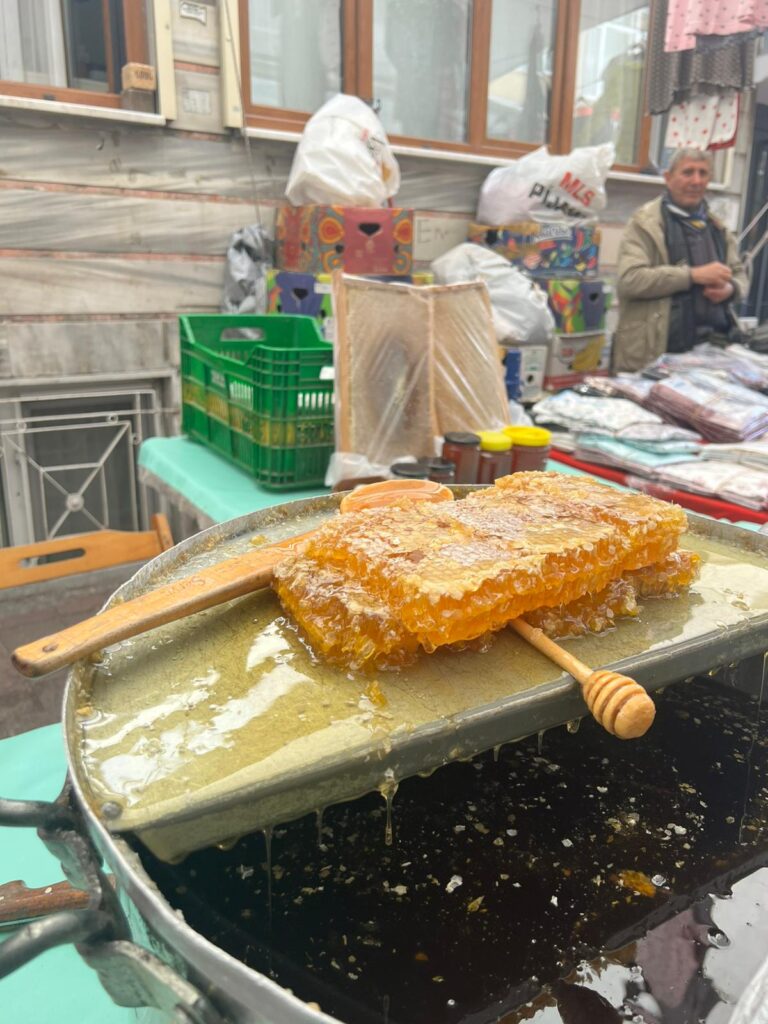
Conclusion: The Soul of Fatih Çarşamba Pazarı — A Place of Return
Fatih Çarşamba Pazarı is not merely a market. It is a living pilgrimage—a return to the rhythms that have sustained Istanbul’s heart for over five centuries. Here, the clatter of copperware, the rustle of handwoven silks, and the murmur of prayers do not compete; they harmonize, weaving a tapestry of Ottoman legacy, Islamic soul, and timeless community care.
For the healing traveler, this pazar is a sanctuary where history breathes. Every herb bundle, every lace-trimmed scarf, every sip of sage tea is an invitation to touch the past while nourishing the present. The vendors, with their ancestral remedies and stories etched into calloused hands, remind us that commerce can be sacred. That a market is not a transaction, but a conversation across generations.
How to Carry the Pazar’s Soul Forward
Walk with Reverence: Let curiosity guide you, but tread lightly. These cobblestones have borne saints, sultans, and seekers long before you.
Listen with Your Heart: The herbalist’s advice, the clang of a coppersmith’s hammer—these are verses in Istanbul’s unending poem.
Choose Mindfully: Support the grandmother selling olives in reused jars, the weaver stitching prayers into scarves. In their crafts, sustainability and spirit intertwine.
“Enter this pazar not as a stranger, but as a guest of history. Let your eyes trace the arabesques on copper trays, your fingers brush the thyme that once healed sultans. Here, time is not a line but a circle—every Wednesday, the past returns, offering its gifts. Listen. The clink of coins is a prayer. The scent of linden is a lullaby. And you? You are both pilgrim and storyteller, adding your steps to a dance that began centuries ago.”
Ready to walk the path of saints and spice traders? Download our free Fatih Healing Itinerary—a guide to markets, mosques, and hidden courtyards where Istanbul’s soul awaits.
“In Fatih, every step is a homecoming. Will you answer the call?” 🌿🕌
Share your pazar stories with us below—we’d love to weave them into our next tale of Istanbul’s sacred markets.
